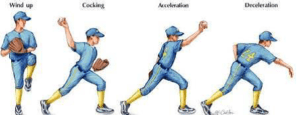Winter conditioning for Spring Sports is in full-swing, and it is not uncommon for athletes to experience pain or discomfort after resuming an exercise or training regimen. We have some tips for baseball or softball players to avoid injuries related to overhead throwing.
- Common injuries associated with overhead throwing:
- Low back injuries
- Muscle strains
- Overuse shoulder injuries
- Elbow pain
- Low back injuries
- Some precautions athletes can take as they begin winter conditioning in order to prevent injuries:
- Focus on good mechanics
- You cannot throw with power without good mechanics
- Incorrect mechanics cause shoulder and elbow injuries
- Maintain a strong core and strong legs
- Weak core and legs will likely cause bad mechanics and increased stress on the shoulder and elbow which leads to injury
- Maintain flexibility of the shoulder
- Shoulder ROM is vital to good throwing mechanics and avoiding injury
- Proper mechanics require adequate shoulder ROM
- If you experience shoulder tightness see your doctor and ask for a referral for physical therapy to improve flexibility
- Do not pitch or throw repetitively when your arm or body is very fatigued
- Maintain strong shoulder, core, and legs for better endurance and decreased fatigue
- Throwing when fatigued results in poor mechanics
- Do not pitch or throw when your shoulder or elbow is in pain
-
- Take a few days off from throwing if you are experiencing pain
- If the pain does not go away in a few days see your doctor and ask for a referral for physical therapy
- Maintain strong rotator cuff and scapular stabilizing muscles
- The follow through motion that occurs with throwing is the fastest human movement recorded
- Forces 1.5 times the thrower’s body weight is attempting to distract the shoulder joint when throwing
- Perform dynamic warmup exercises prior to throwing or practice and static stretching at the end of practice
- Foam roller to posterior shoulder muscles to maintain flexibility and avoid tightness
- Pitchers should not competitively throw more than 9 months in a calendar year
- Know and understand pitch count limits and make sure your coach is aware of the pitch count
- Focus on good mechanics
- Symptoms of an injury that requires medical attention:
- Pain that doesn’t go away with 3 days of rest (no throwing)
- Numbness or tingling in the arm
- How a physical therapist can help:
- Initiate a proper rehabilitation and throwing program
- Improve flexibility and decrease tightness
- Improve shoulder, core, and LE strength, stability, and endurance
- Improve throwing mechanics if mechanics are incorrect
An injury during winter conditioning doesn’t necessarily mean an end to the Spring Season before it even starts. Many injuries can be resolved within a few days or weeks if they are addressed properly. Education on proper mechanics, flexibility and strength can help resolve and prevent injuries. Physical therapy can help an overhead thrower return to playing as quickly and safely as possible. If you are experiencing pain or discomfort from overhead throwing, give us a call – we will help you stay in the game!


